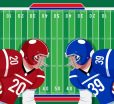NFL Players Who Played Multiple Positions: Versatility At Its Finest

Table Of Contents
The NFL features athletes who excel in their primary positions. But several athletes demonstrate exceptional versatility by performing well in different roles.
These players demonstrate outstanding value to their teams through their ability to excel in various positions beyond their primary role.
The game demands players who can transition between different positions, like running backs catching passes while quarterbacks play tight end.
But why is it so valuable? The main reason is that a multi-position player provides more value to the team. The offense becomes more complex to prepare against when coaches have extra options due to players who can play multiple positions.
We will examine several of the NFL’s all-time great players who have demonstrated versatility in numerous positions.
The Value Of Versatility In The NFL
The National Football League (NFL) was built on the concept of specialization. Each player only has one job — quarterbacks throw, running backs run, wide receivers catch, and linebackers tackle.
This focus allows the players to become experts at their chosen profession to the extreme. Others, however, are exceptions because they break out of those strict molds. They are the men who do not just do one thing, but a lot of things, lots of times at a very high level.
Flexibility in the NFL is about more than switch-hitting from position to position. It is about adaptable, football acumen, and athleticism. Players who can play multiple spots keep defenders silly.
Produce the playbook for offensive coordinators to call from, and offer depth and flexibility up and down the roster. A guy who can contribute in multiple roles often frees up roster space, provides injury insurance, and adds an element of uncertainty that is hard to game plan for.
So why is versatility so valuable? It’s simple: a player who can threat defense in more than one way or contribute to more than one element of the game is worth infinitely more than a single-role player. In a league where games are won by inches, these players are the difference.
Below, we’ll look at several categories of players who have redefined versatility in the NFL and explore why their presence is so impactful.
Running Backs Who Could Have Been Wide Receivers
Historically, running backs are charged with carrying the ball, churning out yards on the ground, and dictating the pace of the offense. But in today’s NFL, many running backs are just as dangerous catching passes out of the backfield.
Guys like Darren Sproles and Reggie Bush are the ideal example. Both had the hands and feet of top-tier wide receivers. They would line up as true running backs, taking drills in between tackles. But then cut over to slot or wideout to get loose in space and stretch the defense.
Darren Sproles (San Diego Chargers, New Orleans Saints, Philadelphia Eagles) was small in stature. But his return kickability, catchability on passes, and ball-running ability made him the most versatile player of his time. Coaches never knew if they were going to use him as a runner, receiver, or returner on any play.
Reggie Bush (New Orleans Saints, Miami Dolphins, Detroit Lions) was one of the traditional dual-threat running backs. His skill set was almost identical to a receiver’s, so he was a terrible matchup for linebackers being asked to cover him.
Today, we have just as much flexibility out of backs like Christian McCaffrey, who has completely redefine the running back position. McCaffrey is consistently posting 1,000+ rushing yards and 1,000+ receiving yards potential in a season. Effectively a running back and a wide receiver rolled into one.
Why it matters: A running back who can pass re-aligns defenses every second. Linebackers are unable to keep up with them, and the defensive backs are too small to be able to tackle them in running situations.
This multi-threat opens a thousandfold of an offense’s possibilities. To give you an example, some running backs could have been wide receivers if they could, showing you just how tempting this type of diversity can be.
Quarterbacks Who Played Multiple Positions
The quarterback position is usually the toughest position in sports, requiring intellect, precision, and command. There are quarterbacks, though, who show they can offer more than passing plays.
The greatest modern-day example is Taysom Hill of the New Orleans Saints. The “Swiss Army Knife” has done it all: quarterback, tight end, fullback, wide receiver, and even special teams.
His utility affords head coach Sean Payton (and later Dennis Allen) the luxury of devising creative and confounding packages. Defensive groups simply cannot schematically plan for how Hill will be used for a particular game.
Another fascinating story is Julian Edelman, started as a quarterback in college, who transitioned into an NFL wide receiver for the New England Patriots. Not only did Edelman become Tom Brady’s favorite target. But his quarterbacking experience provided him with a greater understanding of defensive schemes. Edelman even took snaps and threw touchdown passes on gadget plays occasionally, a nod to his multi-position days.
Further back, Kordell Stewart of the Pittsburgh Steelers earned the nickname “Slash” due to his multi-talented ability to play quarterback, wide receiver, and running back. His multi-position abilities made him one of the precursors of the 1990s NFL multi-positional player.
Why it matters: A quarterback who is great at transitioning into a second position is surprising and can generate brand new plays. Wildcat schemes, trick plays, and hybrid offense formations adore having such players on the field.
Wide Receivers Who Stepped into the Backfield
Wide receivers live and die on route-running, speed, and the ability to stretch the field vertically. There have been receivers. However, they have demonstrated that they are able to make plays in the run game too by lining up in the backfield and accepting handoffs.
Maybe the most dynamic example is Percy Harvin. Harvin had world-class speed and would suddenly shift in the course of an eyeblink. A receiver by formation, he would often line up in the backfield to accept jet sweeps, end-arounds, and plain vanilla handoffs.
His multidimensionality unnerved defenders — would he take a deep pass down the sideline for a big play, or would he shoot out of nowhere with the ball on a rushing play?
Modern football has carried on the trend even more aggressively. San Francisco 49ers’ Deebo Samuel pretty much redefined the wide back role and is currently a wide receiver/rushing back two-way star.
Samuel had nearly 1,800 scrimmage yards in 2021, and over 300 were as a rusher. He showed that a wide receiver can be just as good running handoffs as running routes.
Why it matters: Having a wide receiver who can run the ball forces defenses to always have to adjust game-to-game. Defensive coordinators despise being uncertain, and when receivers begin to appear out of thin air as ball-carriers. It adds an extra level of confusion and complexity to their job.
Defensive Players Who Played Offense
While most of all such instances of versatility are on offense. There are a few defenders who have crossed over to play offense snaps. Less frequent, but when it happens. It is in the way of some of the greatest NFL history has to offer.
Charles Woodson, perhaps the all-time greatest cornerback, occasionally played offense in his youth. His athleticism made him a natural candidate for gadget plays. J.J. Watt, the Houston Texans’ iconic defensive end, was used as a tight end on goal-line formations occasionally. His strength and size made him a mismatch, and he even hauled in touchdown catches.
Another legend is Mike Vrabel, a New England Patriots linebacker, a sleeper jewel at offense. Vrabel accumulated 12 touchdown receptions playing as a goal-line tight end during his playing career. Including two separate Super Bowl touchdowns.
Why it matters: When defensive stars appear on offense, they’re not only creating mismatches, they’re casting doubt upon the game. These are the plays that get the crowd going wild, fool defenses, and have a tendency to turn the momentum.
Special Teams: The Untapped Kingdom of Versatility
One should remember that flexibility is perhaps most pronounced on special teams. As players are frequently called upon to do multiple things.
Kick and punt return specialists like Devin Hester and Cordarrelle Patterson are notable because they showed not only that they could do both kick and punt returns.
But also that they could serve as receivers and running backs. Patterson in particular has mastered two positions, as a top-flight All-Pro returner and an adequate running back.
Why it matters: Special teams get underrated, but a dynamic coverage man or return man can win games with a single play.
Final Thoughts!
The NFL romanticizes specialization, but the greatest players are likely to be those who can do more than one thing very well. A running back who receives like a receiver.
A quarterback who blocks as well as a tight end. A receiver who carries, or a defender who returns a touchdown, is the kind of player who raises the game to a higher level.
Multi-position players aren’t just fun to watch for spectators — they’re gold to coaches who appreciate flexibility, surprise, and creativity in preparation. They save space on the roster, provide unorthodox alignments with potential, and make opponents question all that they do.
The NFL history — from Kordell Stewart and Julian Edelman to Percy Harvin, Deebo Samuel, and Taysom Hill — illustrates versatility is no trick.
It’s a competitive edge. And as the game evolves, we can assure ourselves of seeing ever more players extending the boundaries of what constitutes classic positions. Making the game more dynamic, more exciting, and more surprising than ever before.

























